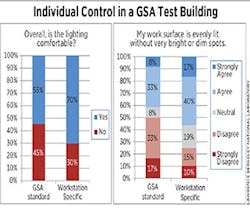You can’t make every occupant happy in an open-plan office, but lighting strategies focused on personal control can help you cut energy consumption and improve occupants’ attitudes and productivity at an increasingly affordable cost.
Could individual lighting controls benefit your facility? Compare your office space to two retrofit examples to assess the potential energy and occupant satisfaction improvements.
Why Lighting Needs Differ
Occupational demands can complicate lighting satisfaction. Someone who uses a computer all day might prefer a dim workspace that doesn’t produce glare or eye fatigue. Others need full brightness for optimal performance.
“The standard thinking is to just connect an occupancy sensor and hardwire it to a bank of switches,” says Danny Yu, CEO of Daintree Networks, which develops wireless control technology. “That has the lowest installed cost, but you end up paying for it because spaces change and occupants have different needs. When the layout is reorganized, someone has to change the sensors, hand-tune them, or take them out.”
Satisfaction levels increase when occupancy sensors are paired with other technologies, such as daylight sensing, wall control, or individual controls, notes Brian Dauskurdas, director of global energy solutions for Lutron Electronics, a developer of lighting control solutions.
“You can let single occupants have a say in how their lights are controlled,” Dauskurdas says. “This idea isn’t new to the market, but based on the cost of the devices, the ability for them to utilize radio frequency (RF), and the new wave of ballasts coming out, you can now have digital control without extra expense.”
Facilities in Focus
At United Stationers, a wholesale distributor of business products, a large retrofit covering the office and breakroom areas of its Sacramento facility contributed to the company’s pursuit of sustainable improvements and cost savings. Spurred by its local utility, United Stationers signed onto a research project studying possible savings from combining office LED fixtures with advanced wireless systems that allowed individual control of overhead lighting in some of the office spaces.
The project resulted in a staggering 94% monthly lighting energy savings over previous energy usage, thanks in part to the replacement of hundreds of fluorescent fixtures with LEDs and the resulting reduction in the number of fixtures in the building.
However, the personal controls in particular resulted in surprising findings, Yu notes of the Daintree control system retrofitted at United Stationers. A majority of occupants keep their light levels partially dimmed and have wholeheartedly embraced the personal remote controls, according to Dave Bisbee of the Sacramento Municipal Utility District, which worked with United Stationers on the retrofit.
A similar research project conducted on behalf of the General Services Administration (GSA) compared occupant satisfaction with workspaces at five test buildings in California and Nevada. Researchers took a baseline measurement of 10-year-old fixtures typical of much of GSA’s inventory and compared it with two retrofit strategies: a space conforming to GSA’s current lighting retrofit standard and another with a centralized control system that allows individual workstations to control light levels.
The results reflected improvements similar to the United Stationers project. For example, at the San Francisco facility, spaces with workstation-specific luminaires charted an average annual energy density of 2.18 kWh per square foot, while the standard retrofit measured 3.45 kWh and the baseline stood at 5.85 kWh.
Even if you can’t afford to retrofit large areas like these, you can still reap significant savings. New lighting and a tighter control system together ensure the best ROI, says Dauskurdas, but the scalability of wireless control devices means you can add them gradually as funding allows.
“It’s common among building owners to think that you need to buy the entire system at once. Historically, that’s true – you’d have to retrofit everything and it would be very expensive,” Dauskurdas adds. “With the proliferation of wireless devices, however, you can literally separate one or two fixtures on a circuit and control them individually.”
Janelle Penny [email protected] is associate editor of BUILDINGS.
About the Author
Janelle Penny
Editor-in-Chief at BUILDINGS
Janelle Penny has been with BUILDINGS since 2010. She is a two-time FOLIO: Eddie award winner who aims to deliver practical, actionable content for building owners and facilities professionals.

